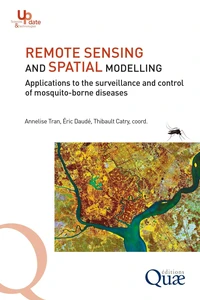Remote Sensing and Spatial Modelling. Applications to the surveillance and control of mosquito - borne diseases
Par : , ,Formats :
Disponible dans votre compte client Decitre ou Furet du Nord dès validation de votre commande. Le format Multi-format est :
- Pour les liseuses autres que Vivlio, vous devez utiliser le logiciel Adobe Digital Edition. Non compatible avec la lecture sur les liseuses Kindle, Remarkable et Sony
 , qui est-ce ?
, qui est-ce ?Notre partenaire de plateforme de lecture numérique où vous retrouverez l'ensemble de vos ebooks gratuitement
Pour en savoir plus sur nos ebooks, consultez notre aide en ligne ici
- Nombre de pages148
- FormatMulti-format
- ISBN978-2-7592-4102-6
- EAN9782759241026
- Date de parution07/07/2025
- Protection num.NC
- Infos supplémentairesMulti-format incluant PDF sans p...
- ÉditeurQuae
- PréfacierDidier Fontenille
Résumé
Mosquitoes are vectors of many disease-causing pathogens, including malaria, dengue, chikungunya, and yellow fever. According to the World Health Organization, these vector-borne diseases account for several hundred thousand deaths annually. They also cause zoonoses, such as Rift Valley fever and West Nile fever.
In this context, the development of operational tools to support surveillance and control strategies is essential-not only in countries of the Global South, where mosquito-borne diseases are most prevalent in tropical and subtropical regions, but also in the countries of the North, where the establishment of invasive species such as the tiger mosquito is increasing the risk of disease emergence.
To address these challenges, Earth observation imagery offers valuable potential: the spatial distribution and seasonal dynamics of mosquito populations are closely linked to climatic factors (such as temperatures, rainfall, and humidity) and environmental variables (such as the presence of water bodies and vegetation), many of which can be monitored through satellite data. Numerous recent studies have led to the development of innovative methods that combine remote sensing with spatial modelling to predict the spatial and temporal dynamics of vector mosquitoes and associated diseases.
Moving beyond proof-of-concept, some of these approaches have given rise to operational tools and processing chains that are now actively used by public health authorities and vector control agencies. This book, intended for students, researchers, and public health professionals, offers a synthesis of current research and operational tools in the field.
To address these challenges, Earth observation imagery offers valuable potential: the spatial distribution and seasonal dynamics of mosquito populations are closely linked to climatic factors (such as temperatures, rainfall, and humidity) and environmental variables (such as the presence of water bodies and vegetation), many of which can be monitored through satellite data. Numerous recent studies have led to the development of innovative methods that combine remote sensing with spatial modelling to predict the spatial and temporal dynamics of vector mosquitoes and associated diseases.
Moving beyond proof-of-concept, some of these approaches have given rise to operational tools and processing chains that are now actively used by public health authorities and vector control agencies. This book, intended for students, researchers, and public health professionals, offers a synthesis of current research and operational tools in the field.
Mosquitoes are vectors of many disease-causing pathogens, including malaria, dengue, chikungunya, and yellow fever. According to the World Health Organization, these vector-borne diseases account for several hundred thousand deaths annually. They also cause zoonoses, such as Rift Valley fever and West Nile fever.
In this context, the development of operational tools to support surveillance and control strategies is essential-not only in countries of the Global South, where mosquito-borne diseases are most prevalent in tropical and subtropical regions, but also in the countries of the North, where the establishment of invasive species such as the tiger mosquito is increasing the risk of disease emergence.
To address these challenges, Earth observation imagery offers valuable potential: the spatial distribution and seasonal dynamics of mosquito populations are closely linked to climatic factors (such as temperatures, rainfall, and humidity) and environmental variables (such as the presence of water bodies and vegetation), many of which can be monitored through satellite data. Numerous recent studies have led to the development of innovative methods that combine remote sensing with spatial modelling to predict the spatial and temporal dynamics of vector mosquitoes and associated diseases.
Moving beyond proof-of-concept, some of these approaches have given rise to operational tools and processing chains that are now actively used by public health authorities and vector control agencies. This book, intended for students, researchers, and public health professionals, offers a synthesis of current research and operational tools in the field.
To address these challenges, Earth observation imagery offers valuable potential: the spatial distribution and seasonal dynamics of mosquito populations are closely linked to climatic factors (such as temperatures, rainfall, and humidity) and environmental variables (such as the presence of water bodies and vegetation), many of which can be monitored through satellite data. Numerous recent studies have led to the development of innovative methods that combine remote sensing with spatial modelling to predict the spatial and temporal dynamics of vector mosquitoes and associated diseases.
Moving beyond proof-of-concept, some of these approaches have given rise to operational tools and processing chains that are now actively used by public health authorities and vector control agencies. This book, intended for students, researchers, and public health professionals, offers a synthesis of current research and operational tools in the field.





